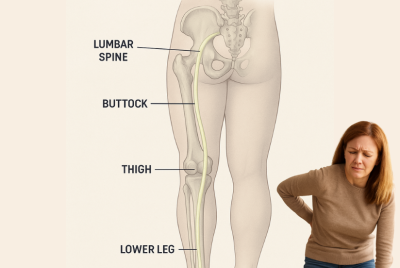Yoga Poses to Avoid with Sciatica: Protecting Your Back and Nerves
Why Yoga Can Help—And Hurt—Sciatica Sufferers
If you live with sciatica, you already know how disruptive it can be. Sharp pain shooting down your leg, numbness in your foot, or difficulty sitting for more than a few minutes can make everyday life exhausting. Many people turn to yoga for relief, and while gentle stretches can help reduce muscle tension and improve mobility, not all poses are safe. In fact, some common yoga positions can worsen sciatic nerve compression, leading to flare-ups of pain, tingling, or weakness. This article will guide you through the yoga poses to avoid with sciatica, why they aggravate symptoms, and what safe alternatives you can practice instead. By the end, you’ll understand how to approach yoga with confidence and protect your back while still enjoying its benefits.
Understanding Sciatica: Why Some Movements Trigger Pain
Before diving into specific yoga poses, it’s important to understand what’s happening in your body.
-
Sciatica occurs when the sciatic nerve is irritated or compressed.
-
Common causes include herniated discs, piriformis syndrome, spinal stenosis, and chronic wallet sciatica (caused by sitting with a bulky wallet).
-
Symptoms often include lower back pain, pain running down the leg, tingling, or numbness.
Movements that overstretch the hamstrings, twist the spine aggressively, or compress the lower back can increase irritation. That’s why knowing which poses to avoid is critical if you want lasting sciatica pain relief.
Yoga Poses to Avoid with Sciatica
1. Seated Forward Fold (Paschimottanasana)
-
Why to avoid: This pose deeply stretches the hamstrings and pulls on the lower back, which can increase sciatic nerve irritation.
-
Alternative: Try a gentle hamstring stretch while lying on your back with one leg extended and supported by a strap.
2. Full Lotus Pose (Padmasana)
-
Why to avoid: Crossing the legs tightly can compress the sciatic nerve and strain the hips, especially for those with piriformis syndrome sciatica.
-
Alternative: Sit cross-legged with support under your hips or use a chair to maintain good posture without nerve compression.
3. Standing Forward Bend (Uttanasana)
-
Why to avoid: Similar to seated folds, this pose overstretches the hamstrings and pulls on the lower back.
-
Alternative: Use a half-forward bend with hands on a wall or yoga blocks to reduce pressure on your lower spine.
4. Pigeon Pose (Eka Pada Rajakapotasana)
-
Why to avoid: Although often recommended for hip opening, the pigeon pose can aggravate sciatic nerve pain by overstretching the piriformis muscle.
-
Alternative: The Supine figure-four stretch on your back is gentler and gives more control over intensity.
5. Boat Pose (Navasana)
-
Why to avoid: Holding this pose puts intense strain on the lower back and hip flexors, potentially worsening nerve compression.
-
Alternative: Core strengthening with dead bug or bird-dog exercises is safer for sciatica sufferers.
6. Downward Dog (Adho Mukha Svanasana)
-
Why to avoid: For some people, this pose overextends tight hamstrings and pulls on the lower back, triggering pain.
-
Alternative: Puppy pose (half downward dog) at the wall provides stretch without full weight on the lower back.
7. Revolved Triangle Pose (Parivrtta Trikonasana)
-
Why to avoid: Twisting and folding at the same time can irritate herniated discs and increase sciatic nerve pain.
-
Alternative: Gentle supine spinal twists with knees supported are much safer.
Safer Yoga Practices for Sciatica Relief
Even if there are yoga poses to avoid with sciatica, many others can bring relief when practiced carefully:
-
Cat-Cow Stretch: Promotes spinal mobility without overstraining.
-
Bridge Pose: Strengthens glutes and stabilizes the lower back.
-
Child’s Pose (modified): Gentle release for the spine when supported with pillows.
-
Pelvic Tilts: An Easy way to engage the core and release tension in the lumbar spine.
-
Sciatica stretches at home: Hamstring stretches with a strap, gentle piriformis stretches, and hip openers performed on your back.
Always listen to your body. If pain worsens, stop immediately.
Lifestyle Tips to Support Sciatica Healing
Living with sciatica often means more than just managing pain during flare-ups. The way you sit, sleep, exercise, and even eat can all affect how quickly your body recovers and how often symptoms return. Here are the most effective lifestyle changes to support sciatica relief:
1. Optimize Your Sitting Habits
-
Avoid wallet sciatica: Never sit with a bulky wallet or phone in your back pocket, as this tilts your pelvis and compresses the sciatic nerve.
-
Use ergonomic seating: Choose chairs with lumbar support. In offices across the U.S., brands like Herman Miller and Steelcase are popular for long-term back health.
-
Take movement breaks: Every 30 minutes, stand up, walk, or stretch to reduce nerve compression.
2. Improve Your Sleeping Position
-
Best sleeping position for sciatica: Side sleeping with a pillow between your knees helps keep the spine aligned. If you prefer back sleeping, place a pillow under your knees to reduce lower back strain.
-
Invest in the right mattress: Medium-firm mattresses often work best for those with chronic sciatica, according to U.S. sleep studies.
3. Stay Active with Low-Impact Exercise
-
Walking with sciatica pain: Short, frequent walks are often better than long, strenuous sessions. Walking helps reduce stiffness and improve circulation.
-
Gentle sciatica stretches at home: Cat-cow, bridge pose, and pelvic tilts can strengthen supportive muscles without irritating the nerve.
-
Swimming and water aerobics: Water reduces pressure on the spine, making it easier to exercise without triggering pain.
4. Use Heat and Ice Wisely
-
Heat or ice for sciatica: Ice packs are best for acute flare-ups (first 48 hours) to reduce inflammation. Heat pads or warm baths help with chronic stiffness by improving blood flow.
-
Many U.S. drugstores (CVS, Walgreens, Walmart) sell affordable heat/ice combo packs.
5. Focus on Anti-Inflammatory Nutrition
-
Natural remedies for sciatica: Anti-inflammatory foods like salmon, turmeric, berries, and leafy greens support healing.
-
Limit triggers: Reduce processed foods, sugar, and excessive caffeine, which may worsen nerve pain for some people.
-
Stay hydrated: Proper hydration supports spinal disc health and reduces stiffness.
6. Manage Stress and Posture
-
Stress relief: Chronic stress can increase muscle tension, making sciatica worse. Yoga (modified), meditation, or breathing exercises can help.
-
Posture correction: Poor posture leads to sciatic nerve compression. Consider posture correctors or simple reminders to sit upright during work.
7. Prioritize Physical Therapy and Strengthening
-
Many Americans benefit from sciatica physical therapy, where a therapist teaches personalized stretches and strengthening routines.
-
Core, glute, and hip muscle strengthening helps stabilize the spine and reduce sciatic nerve irritation.
👉 By combining these lifestyle adjustments with safer yoga practices, you’ll build a stronger foundation for long-term relief. Many people find that these daily habits—not just treatments—are what keep sciatica flare-ups under control.
Medical and Home Treatment Options
If yoga adjustments and lifestyle changes aren’t enough, consider these options:
-
Sciatica pain treatment at home: Over-the-counter NSAIDs, gentle stretching, and heat therapy.
-
Physical therapy: Structured sciatica physical therapy can target weak areas and improve mobility.
-
Medical treatments: Corticosteroid injections or surgical options may be needed for severe cases like herniated disc sciatica.
-
Chronic sciatica management: Long-term strategies may include posture correction, weight management, and consistent exercise.
What Causes Sciatica Flare-Ups in Yoga?
Flare-ups often happen because of:
-
Overstretching hamstrings
-
Holding poses too long
-
Poor alignment in twisting poses
-
Sitting positions that compress the sciatic nerve
By avoiding the poses above, you’ll reduce the risk of pain spikes and protect your lower back.
Sciatica Daily Routine Checklist
Use this routine to reduce pain, prevent flare-ups, and support long-term healing. Adjust based on your doctor’s recommendations and your body’s needs.
🌅 Morning Routine
-
Gentle Wake-Up Stretches
-
Try cat-cow, pelvic tilts, or a supported hamstring stretch before getting out of bed.
-
Avoid forward folds or aggressive twists first thing in the morning.
-
-
Heat or Ice (as needed)
-
If you wake with stiffness, apply a warm compress for 10 minutes.
-
For acute flare-ups, use ice instead.
-
-
Balanced Breakfast
-
Choose anti-inflammatory foods like oatmeal with berries, avocado toast, or scrambled eggs with spinach.
-
Stay hydrated — start with a glass of water.
-
☀️ Daytime Routine
-
Work & Sitting Habits
-
Avoid wallet sciatica by keeping your back pockets empty.
-
Use lumbar support (pillow or ergonomic chair).
-
Stand and stretch every 30 minutes.
-
-
Movement Breaks
-
Take short walks to improve circulation and reduce stiffness.
-
Try sciatica stretches at home or in the office, like the seated figure-four.
-
-
Midday Nutrition
-
Anti-inflammatory lunch ideas: grilled salmon with quinoa, leafy greens, and olive oil dressing.
-
Limit sugar and processed foods to prevent inflammation.
-
🌙 Evening Routine
-
Gentle Exercise or Walking
-
Go for a short walk after dinner to reduce lower back pain and keep muscles loose.
-
Swimming or light yoga (safe poses only) can also help.
-
-
Relaxation & Stress Relief
-
Practice deep breathing, meditation, or journaling to release tension.
-
Stress often makes sciatic nerve pain worse.
-
-
Best Sleeping Position for Sciatica
-
Side sleeping: Place a pillow between your knees.
-
Back sleeping: add a pillow under your knees.
-
Avoid stomach sleeping, which strains the spine.
-
✅ Quick Recap Checklist
-
Morning stretches before getting out of bed
-
Heat or ice therapy as needed
-
Anti-inflammatory meals + hydration
-
No wallet in the back pocket while sitting
-
Walk or stretch every 30 minutes
-
Evening walk or gentle yoga
-
Sleep in a spine-supported position
👉 Consistency is key. By following this sciatica daily routine, you’ll support nerve healing, reduce flare-ups, and regain control of your day-to-day life.
FAQs: Yoga Poses to Avoid with Sciatica
1. Can yoga make sciatica worse?
Yes, specific yoga poses like forward folds and pigeon pose can overstretch muscles or compress nerves, worsening symptoms. Always choose gentle, controlled movements for sciatica pain relief.
2. Should I stop yoga completely if I have sciatica?
No. You don’t need to stop yoga altogether. Instead, avoid risky poses and focus on gentle stretches, strengthening, and relaxation techniques recommended by your doctor or therapist.
3. Is pigeon pose safe for sciatica?
Pigeon pose is risky because it can strain the piriformis muscle. A safer option is the supine figure-four stretch, which gives more control and less pressure on the sciatic nerve.
4. What yoga stretches are best for sciatica relief?
Safe options include cat-cow stretch, bridge pose, supported child’s pose, and gentle hamstring stretches using a strap. These reduce tension without irritating the sciatic nerve.
5. Can yoga cure sciatica naturally?
Yoga cannot cure sciatica, but it can manage symptoms, improve flexibility, and support recovery when combined with lifestyle changes and medical care if needed.
6. Why does my leg hurt more after yoga?
If your leg pain worsens after yoga, you may be overstretching or compressing the nerve with unsafe poses. Stop immediately and consult a physical therapist for guidance.
7. What are the best alternatives to forward bends for sciatica?
Half-forward bends at the wall, supine hamstring stretches, or supported restorative poses are safer options that reduce nerve strain while still providing flexibility benefits.
Conclusion: Protect Your Back While Practicing Yoga
Yoga can be a powerful tool for healing—but only when practiced wisely. By knowing the yoga poses to avoid with sciatica and replacing them with safer alternatives, you’ll reduce the risk of flare-ups, ease sciatic nerve compression, and support long-term relief. Always listen to your body, use props for support, and seek professional guidance if pain persists.
Disclaimer
This article is for educational purposes only and is not a substitute for medical advice. Always consult with a healthcare provider before starting or modifying any exercise program, especially if you have chronic sciatica or other medical conditions.

- Why Does Sciatica Hurt More in the Morning?
- Numbness in Foot from Sciatica
- Sciatica Relief Stretches for Beginners





